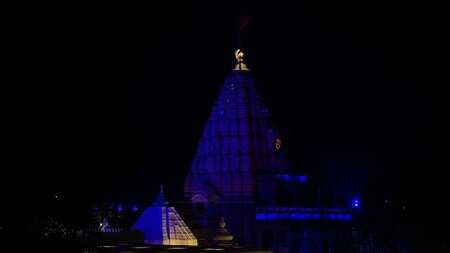JUPITER
Times of Bennett | Updated: May 23, 2023 14:09

-By Kushagra Singh
Jupiter , the largest planet in our solar system, is a magnificent gas giant that reigns supreme among its celestial neighbors. With its awe-inspiring size, mesmerizing storms, and intriguing composition, Jupiter has captivated the imagination of astronomers and space enthusiasts for centuries. In this blog post, we embark on a journey to explore the grandeur and mysteries of the mighty Jupiter.
TheKing of Planets :
We begin by introducing Jupiter as the largest planet in our solar system, providing an overview of its size, mass, and unique characteristics. We'll compare its colossal size to other planets and delve into the awe-inspiring fact that Jupiter could accommodate all the other planets combined within its voluminous atmosphere.
A Glimpse Into Jupiter's Atmosphere:
Jupiter's atmosphere is a captivating realm of swirling storms and intricate cloud formations. We'll explore its famous feature, the Great Red Spot—a colossal storm that has raged for centuries. Additionally, we'll discuss the bands of clouds, including the alternating light and dark stripes that adorn Jupiter's surface, and the mesmerizing cyclones observed by space probes.
Moons Galore:
Jupiter is accompanied by a retinue of moons, a veritable mini-solar system in itself. We'll explore the four largest and most well-known Galilean moons—Io, Europa, Ganymede, and Callisto—and their unique characteristics. From volcanic activity on Io to the potential for subsurface oceans on Europa, these moons offer intriguing possibilities for the existence of life beyond Earth.
Jupiter's Magnetic Field:
Jupiter possesses a colossal and complex magnetic field that extends far into space. We'll examine the origins of this magnetic field, the processes that generate it, and its interaction with Jupiter's atmosphere. We'll also discuss the fascinating phenomenon of Jupiter's auroras, which are more powerful and spectacular than Earth's.
TheJuno Mission:
NASA 's Juno spacecraft , launched in 2011, has provided valuable insights into Jupiter's composition, structure, and magnetic field. We'll delve into the objectives and discoveries of the Juno mission, including the measurement of the planet's gravitational and magnetic fields, and the investigation of its internal structure and atmospheric dynamics.
Jupiter and Planetary Formation:
Jupiter's formation and evolution hold important clues about the early stages of our solar system. We'll explore the role Jupiter plays in shaping the architecture of our planetary system and its influence on the formation of other planets. Additionally, we'll discuss the ongoing research and theories surrounding Jupiter's core and its potential impact on the planet's characteristics.
Conclusion:
Jupiter, with its colossal size, turbulent atmosphere, and intriguing moons, continues to astound and inspire us. As we explore the mysteries of this gas giant, we uncover insights into the processes that shape our solar system and the possibilities of life beyond Earth. From the ongoing Juno mission to future explorations, our journey into the realm of Jupiter promises to unveil more of its secrets and expand our understanding of the vast and wondrous universe we inhabit.
The
We begin by introducing Jupiter as the largest planet in our solar system, providing an overview of its size, mass, and unique characteristics. We'll compare its colossal size to other planets and delve into the awe-inspiring fact that Jupiter could accommodate all the other planets combined within its voluminous atmosphere.
A Glimpse Into Jupiter's Atmosphere:
Jupiter's atmosphere is a captivating realm of swirling storms and intricate cloud formations. We'll explore its famous feature, the Great Red Spot—a colossal storm that has raged for centuries. Additionally, we'll discuss the bands of clouds, including the alternating light and dark stripes that adorn Jupiter's surface, and the mesmerizing cyclones observed by space probes.
Moons Galore:
Jupiter is accompanied by a retinue of moons, a veritable mini-solar system in itself. We'll explore the four largest and most well-known Galilean moons—Io, Europa, Ganymede, and Callisto—and their unique characteristics. From volcanic activity on Io to the potential for subsurface oceans on Europa, these moons offer intriguing possibilities for the existence of life beyond Earth.
Jupiter's Magnetic Field:
Jupiter possesses a colossal and complex magnetic field that extends far into space. We'll examine the origins of this magnetic field, the processes that generate it, and its interaction with Jupiter's atmosphere. We'll also discuss the fascinating phenomenon of Jupiter's auroras, which are more powerful and spectacular than Earth's.
The
Jupiter and Planetary Formation:
Jupiter's formation and evolution hold important clues about the early stages of our solar system. We'll explore the role Jupiter plays in shaping the architecture of our planetary system and its influence on the formation of other planets. Additionally, we'll discuss the ongoing research and theories surrounding Jupiter's core and its potential impact on the planet's characteristics.
Conclusion:
Jupiter, with its colossal size, turbulent atmosphere, and intriguing moons, continues to astound and inspire us. As we explore the mysteries of this gas giant, we uncover insights into the processes that shape our solar system and the possibilities of life beyond Earth. From the ongoing Juno mission to future explorations, our journey into the realm of Jupiter promises to unveil more of its secrets and expand our understanding of the vast and wondrous universe we inhabit.











